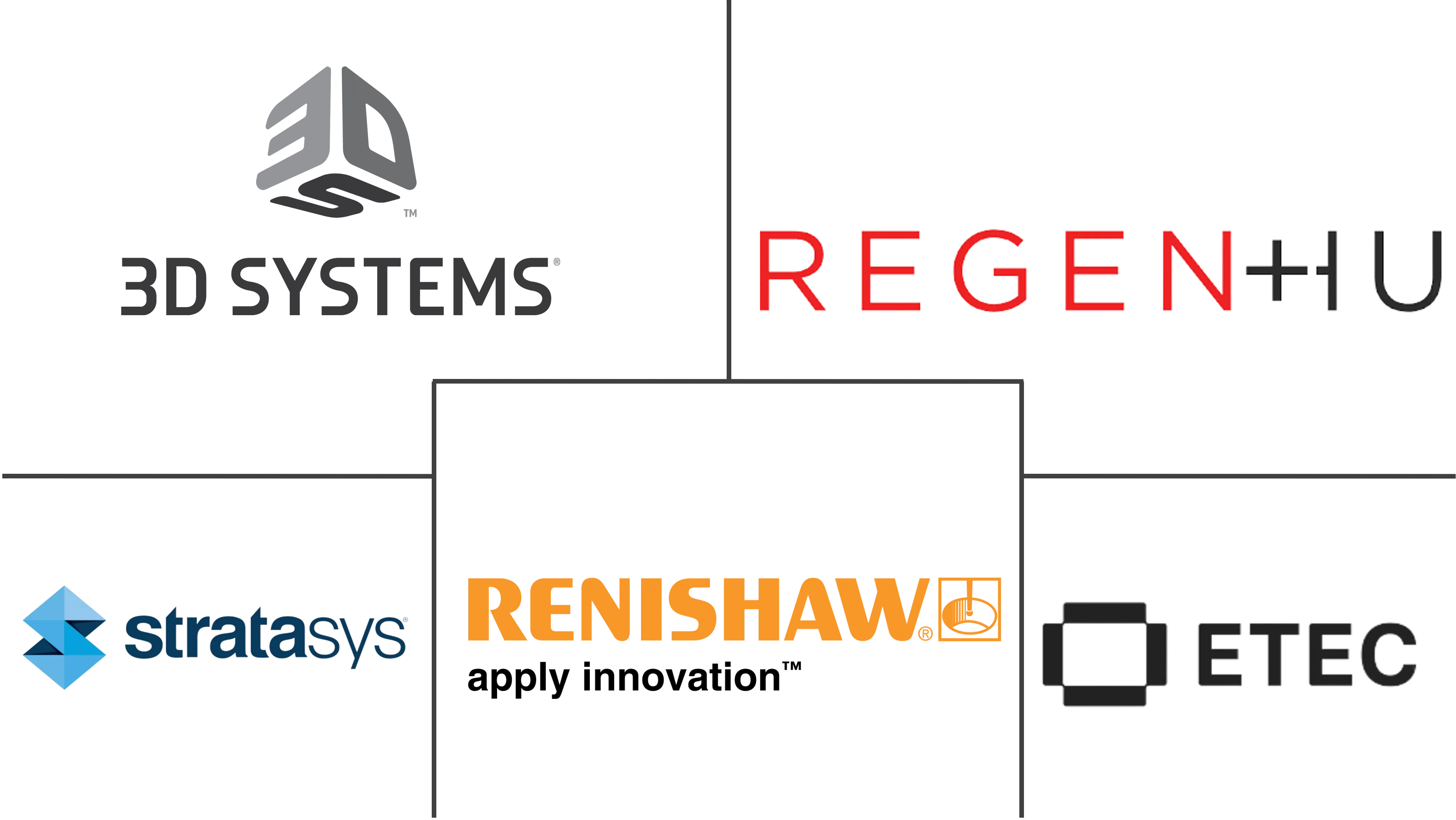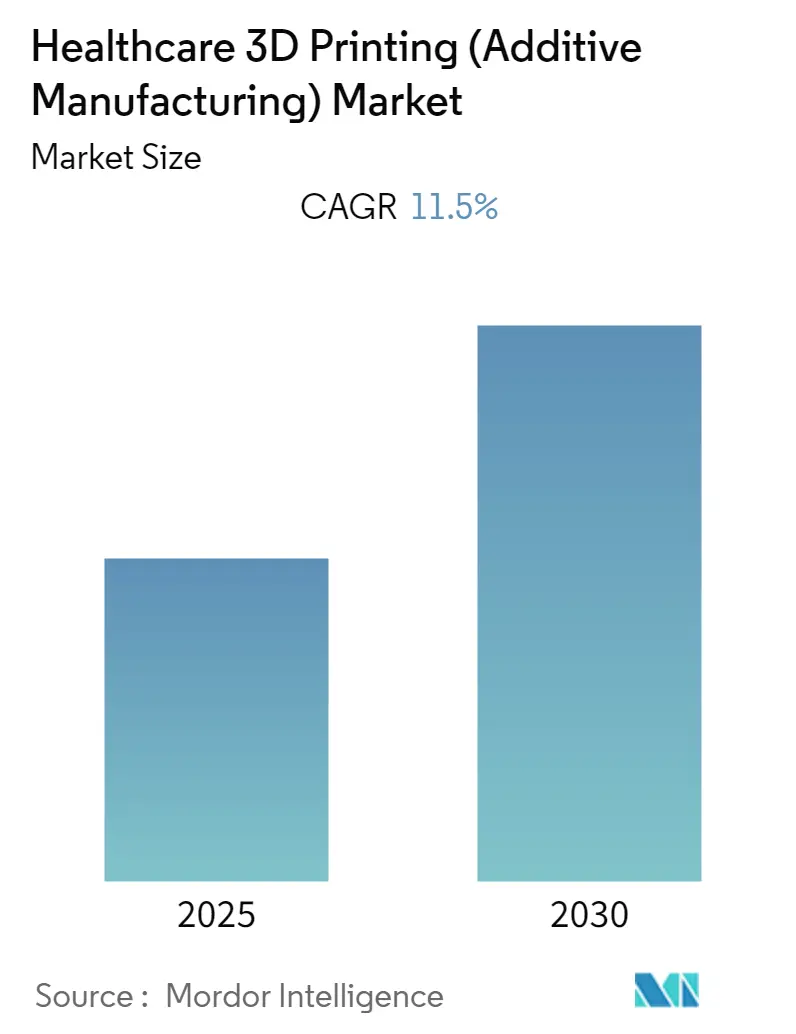
Healthcare 3D Printing Market Analysis
The Healthcare 3D Printing Market is expected to register a CAGR of 11.5% during the forecast period.
COVID-19 significantly impacted the additive manufacturing field in its initial phases. It faced a lack of medical devices during the pandemic. Diverse designs were produced and used in hospitals by patients and health workers, and there has been an increase in the use of 3D-printed devices, such as face shields, masks, valves, and nasopharyngeal swabs. However, as the restrictions were lifted, the demand for the market is likely to increase in the coming years since complete automation and digital workflow are anticipated to be possible with additive manufacturing. In particular, additive manufacturing is likely to replace high-volume, serial production techniques that require both high resolution and high productivity at low cost.
Additive manufacturing, often referred to as 3D printing, has the potential to provide cost-efficient methods to produce highly complex and customized components, single parts, or small batches of products for the healthcare industry. It has numerous applications in the industry. Factors such as rising demand for customized additive manufacturing and demand for 3D printing, driven by increased medical applications, are major driving forces in the market's expansion. For instance, in March 2022, Zoriox Innovation Labs, consisting of a team of surgeons, dentists, mechanical engineers, biomedical engineers, software engineers, graphic designers, prosthetists, and anatomists, created a 360-degree solution for facial reconstruction using 3D printing technology. Moreover, in February 2022, South Carolina-based DeGen Medical Inc., a spinal implant manufacturer focused on Augmented Reality and Patient-Specific Solutions, commercially launched Impulse AM, a 3D-printed porous titanium implant for posterior interbody fusion.
Also, many hearing aids are 3D printed with current innovations and technological advancements, making it one of the important factors to positively drive this market over the forecast period. Further, technological advances are contributing to the market's growth. 3D printing in medicine can provide many benefits, like the customization and personalization of medical products, drugs, and equipment and increased productivity. For instance, in February 2021, Apollo Hospitals and Anatomiz3D Medtech collaborated to design and build hospital 3D printing labs in India that enabled doctors to visualize and print implants for complicated surgical cases. Furthermore, in April 2022, Desktop Health, a healthcare business that creates 3D-printing solutions for personalized medicine, launched the Einstein high-precision series of 3D printers and the Flexcera Smile Ultra+ resin for printing temporary and definitive restorations in the United States. This combination enables dental professionals to quickly generate accurate 3D-printed restorations.
As per the factors mentioned above, healthcare 3D printing (additive manufacturing) is likely to witness growth over the forecast period. However, the cost of additive manufacturing is still high, leading to affordability issues, especially in developing and underdeveloped countries. Also, there is a lack of skilled professionals to operate this machinery. These factors are anticipated to impede the market's growth.
Healthcare 3D Printing Market Trends
Polymers Segment are Expected to Register a Significant Growth in Healthcare 3D Printing (Additive Manufacturing) Market Over the Forecast Period
Polymers and their composites are one of the most widely used additive manufacturing materials due to their vast potential for various applications in healthcare. Polymer-based additive manufacturing has been used for decades in creating prosthetic limb parts as well as medical instruments. These polymers are also used to make plasters specifically for each patient that not only hold the structure to ensure healing but are also comfortable as they can be customized for each patient. This is done using a machine that combines additive manufacturing with 3D scanning procedures and is capable of scanning a patient's limb and printing custom plasters in an incredibly short time.
Moreover, polymers are also used in crafting hearing aids, preparing models that can aid in diagnosis and preoperative planning, and preparing models of organs or specific body parts that can be developed for practice purposes to demonstrate various sensitive surgical procedures such as osteotomies. For instance, in June 2022, a team of researchers from the University of Oklahoma developed a 3D-printed human ear model for standardizing blast exposure testing of hearing protection devices (HPDs). According to the researchers, utilizing 3D printing technology is anticipated to substantially improve the evaluation of HPDs through increased personalization, improved cost-effectiveness, and time efficiency. Hence, such research initiatives associated with the application of 3D printing are likely to boost market growth over the forecast period.
The presence of competitors, mergers, acquisitions, and collaboration in the field of healthcare additive manufacturing drive market growth as these activities are likely to help increase competition as well as the availability of the products. For instance, in February 2022, South Carolina-based 3D Systems agreed to acquire Kumovis, a healthcare-focused additive manufacturing technology startup based in Munich. With the acquisition, 3D Systems reported that it was anticipated to add a unique extrusion technology to its polymer 3D printing portfolio and further expand offerings in the personalized healthcare market.
Hence, considering the above-mentioned factors, the polymer segment is anticipated to witness growth over the forecast period.
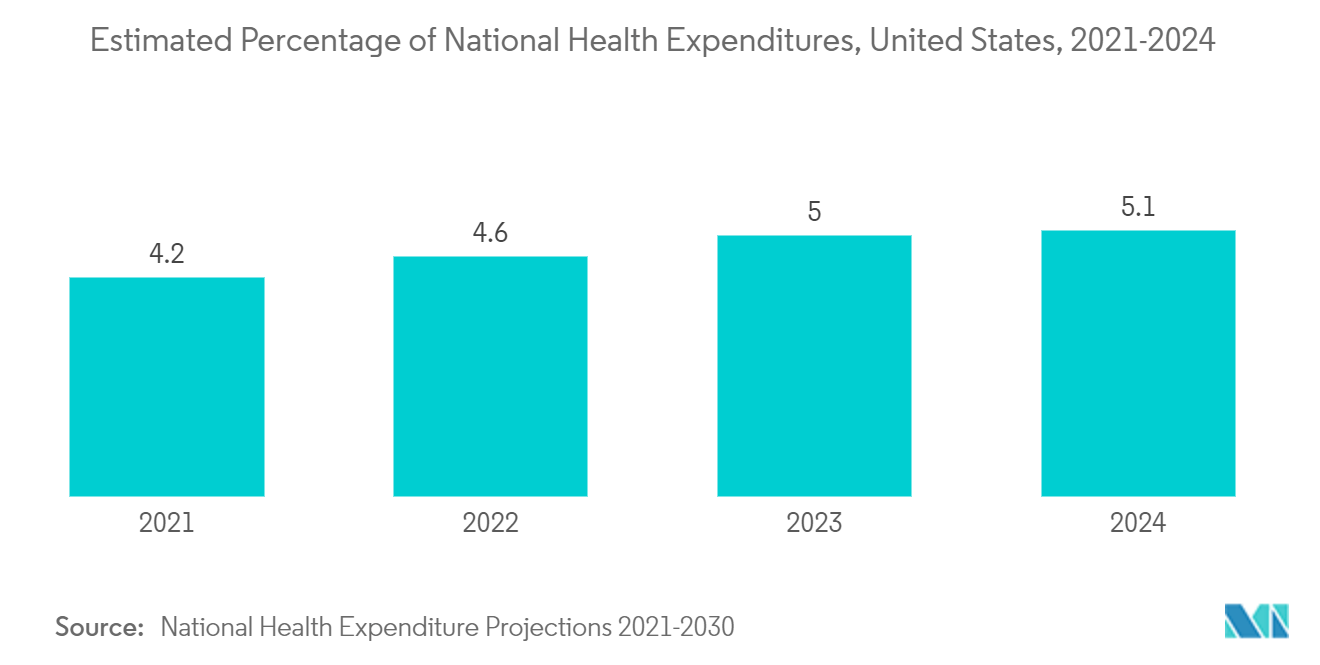
North America is Expected to Witness a Growth in the Healthcare 3D Printing Market Over the Forecast Period
North America is likely to experience growth in the healthcare 3D printing (additive manufacturing) market owing to the increased adoption of customized additive manufacturing and 3D printing demand driven by increased medical applications. Increased 3D printing initiatives with the government's support are also boosting the market growth in North America. For instance, in May 2022, President Biden joined five US manufacturers to celebrate the launch of the Additive Manufacturing Forward (AM Forward). AM Forward is a voluntary compact among manufacturers to help their smaller U.S.-based suppliers increase their use of additive manufacturing.
Moreover, the rising demand for customized implants during surgical procedures, coupled with growing R&D investments, is also boosting the 3D printing market's growth. For instance, in the United States, Ohio State University, in collaboration with Nexxt Spine, LLC, is conducting a clinical trial to evaluate and compare radiographic and clinical outcomes (Clinical trial updated 2021, NCT03647501) in patients who are to undergo combined interbody/posterolateral lumbar fusion procedures, supplemented with pedicle screw instrumentation, using the Nexxt Spine Nexxt MatrixxTM 3D-printed titanium cage or the HonourTM poly-ether-ether-ketone cage. Additionally, in November 2021, EOS, a supplier of responsible manufacturing solutions via industrial 3D printing technology, announced the addition of a new material, EOS Aluminum Al2139 AM. EOS' highest-strength aluminum alloy for 3D printing enables companies to significantly reduce part weight. Such increased research activities in the region relating to 3D printing are likely to boost market growth during the forecast period.
Furthermore, in October 2021, CHU de Québec-Université Laval and Investissement Québec - CRIQ received Health Canada's approval of the first 3D-printed medical implant developed by the 3D anatomical reconstruction laboratory (LARA 3D) at Investissement Québec - CRIQ's facilities in Quebec City, Canada. This was the first time a Canadian company had been granted permission to manufacture an implanted medical device in Canada. Patients with oral cancer undergo mandibular reconstruction using the patient-specific 3D Specifit mandibular plate.
Hence, considering the above-mentioned factors, North America is likely to witness growth over the forecast period.
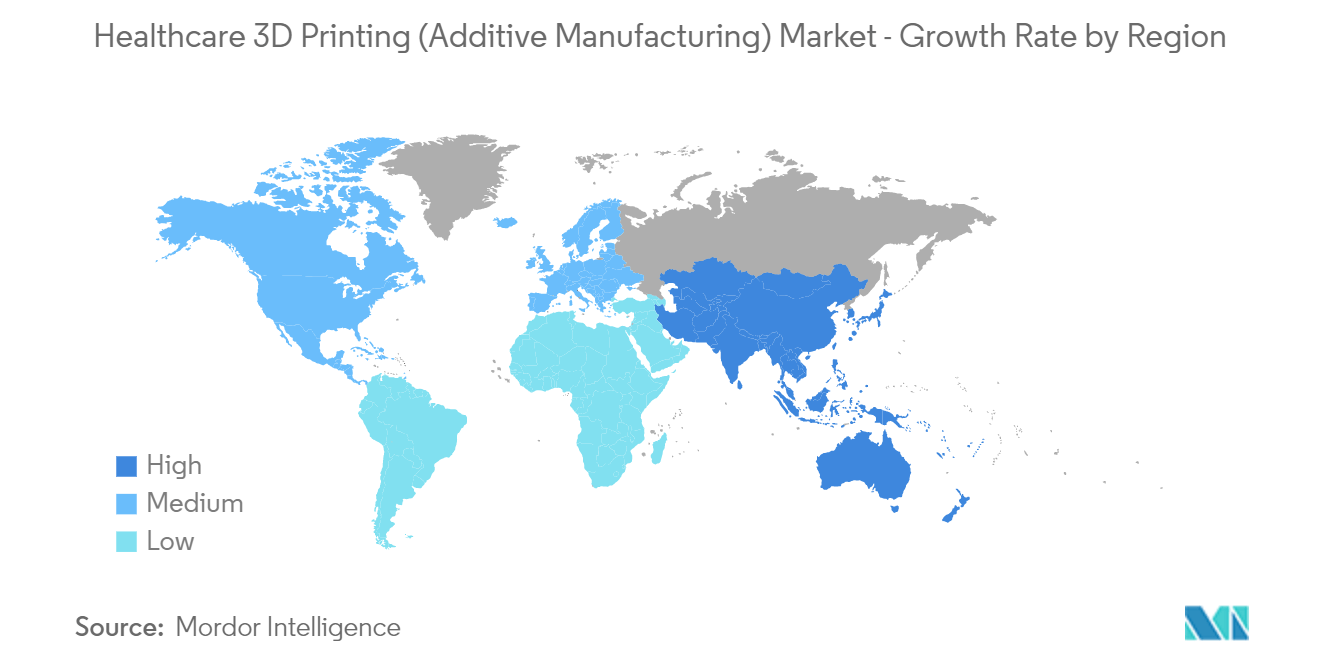
Healthcare 3D Printing Industry Overview
The healthcare 3D printing (additive manufacturing) market is fragmented in nature due to the presence of several companies operating globally as well as regionally. Key players engage in strategic movements such as mergers, acquisitions collaborations for increasing product availability. The competitive landscape includes an analysis of a few international and local companies that hold market shares and are well known. Include 3D Systems Inc, EnvisionTEC, Renishaw PLC, etc among others.
Healthcare 3D Printing Market Leaders
-
3D Systems Inc
-
regenHU Ltd
-
Stratasys Ltd
-
EnvisionTEC
-
Renishaw PLC
- *Disclaimer: Major Players sorted in no particular order
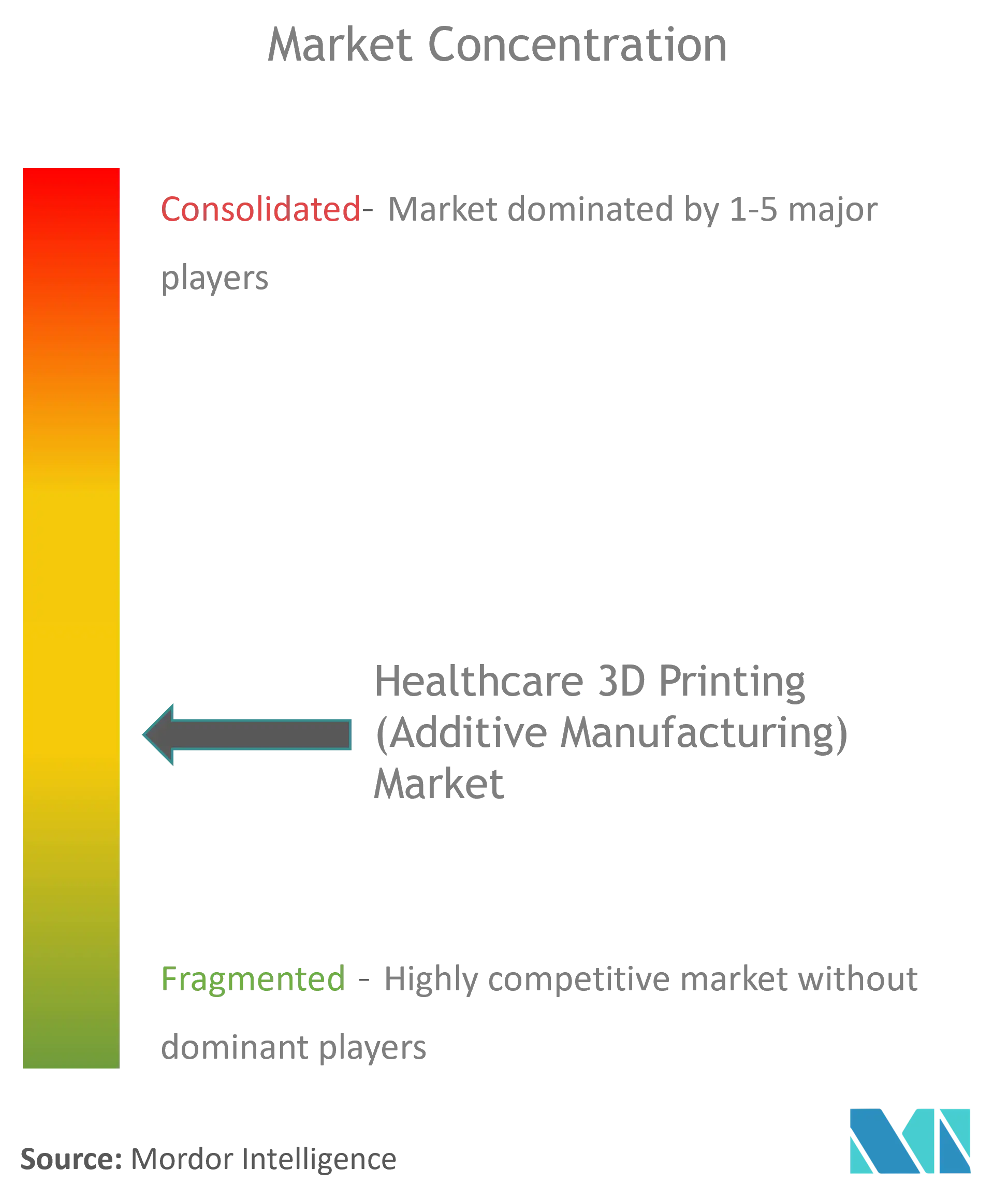
Healthcare 3D Printing Market News
- November 2022: Evonik launched three new INFINAM photopolymers for industrial 3D applications, expanding their photo-resins product line. The product line is intended for use in common UV-curing 3D printing processes. The INFINAM RG 2000 L is a photo resin for the eyewear industry.
- June 2022: Belgian contract manufacturer Amnovis and medical device service provider BAAT Medical teamed up to offer an innovative and rapid turnaround process for 3D-printed medical devices. Both Amnovis and BAAT Medical have experience in 3D printing medical devices for a range of certified end-use applications.
Healthcare 3D Printing Industry Segmentation
As per the scope of the report, 3D printing, or additive manufacturing, is a transformative approach to industrial production that enables the creation of lighter, stronger parts and systems. In healthcare, this approach is used to create implants, instrument parts, and dummy body parts and organs. The Healthcare 3D Printing (Additive Manufacturing) Market is Segmented by Technology (Stereolithography, Deposition Modeling, Electron Beam Melting, Laser Sintering, Jetting Technology, Laminated Object Manufacturing, Other Technologies) by Application (Medical Implants, Prosthetics, Wearable Devices, Tissue Engineering, Other Applications), by Material (Metals and Alloys, Polymers and Other Materials), and by Geography (North America, Europe, Asia-Pacific, South America, Middle East and Africa). The market report also covers the estimated market sizes and trends for 17 countries across major regions globally. The report offers the value (in USD million) for the above segments.
| By Technology | Stereolithography | ||
| Deposition Modeling | |||
| Electron Beam Melting | |||
| Laser Sintering | |||
| Jetting Technology | |||
| Laminated Object Manufacturing | |||
| Other Technologies | |||
| By Application | Medical Implants | ||
| Prosthetics | |||
| Wearable Devices | |||
| Tissue Engineering | |||
| Other Applications | |||
| By Material | Metals and Alloys | ||
| Polymers | |||
| Other Materials | |||
| Geography | North America | United States | |
| Canada | |||
| Mexico | |||
| Europe | Germany | ||
| United Kingdom | |||
| France | |||
| Italy | |||
| Spain | |||
| Rest of Europe | |||
| Asia-Pacific | China | ||
| Japan | |||
| India | |||
| Australia | |||
| South Korea | |||
| Rest of Asia-Pacific | |||
| Middle East and Africa | GCC | ||
| South Africa | |||
| Rest of Middle East and Africa | |||
| South America | Brazil | ||
| Argentina | |||
| Rest of South America | |||
Healthcare 3D Printing Market Research FAQs
What is the current Healthcare 3D Printing (Additive Manufacturing) Market size?
The Healthcare 3D Printing (Additive Manufacturing) Market is projected to register a CAGR of 11.5% during the forecast period (2025-2030)
Who are the key players in Healthcare 3D Printing (Additive Manufacturing) Market?
3D Systems Inc, regenHU Ltd, Stratasys Ltd, EnvisionTEC and Renishaw PLC are the major companies operating in the Healthcare 3D Printing (Additive Manufacturing) Market.
Which is the fastest growing region in Healthcare 3D Printing (Additive Manufacturing) Market?
Asia-Pacific is estimated to grow at the highest CAGR over the forecast period (2025-2030).
Which region has the biggest share in Healthcare 3D Printing (Additive Manufacturing) Market?
In 2025, the North America accounts for the largest market share in Healthcare 3D Printing (Additive Manufacturing) Market.
What years does this Healthcare 3D Printing (Additive Manufacturing) Market cover?
The report covers the Healthcare 3D Printing (Additive Manufacturing) Market historical market size for years: 2019, 2020, 2021, 2022, 2023 and 2024. The report also forecasts the Healthcare 3D Printing (Additive Manufacturing) Market size for years: 2025, 2026, 2027, 2028, 2029 and 2030.
Our Best Selling Reports
Healthcare 3D Printing Industry Report
Statistics for the 2025 Healthcare 3D Printing (Additive Manufacturing) market share, size and revenue growth rate, created by Mordor Intelligence™ Industry Reports. Healthcare 3D Printing (Additive Manufacturing) analysis includes a market forecast outlook for 2025 to 2030 and historical overview. Get a sample of this industry analysis as a free report PDF download.

